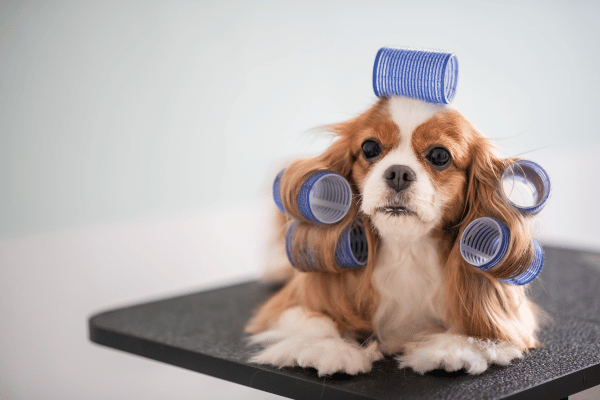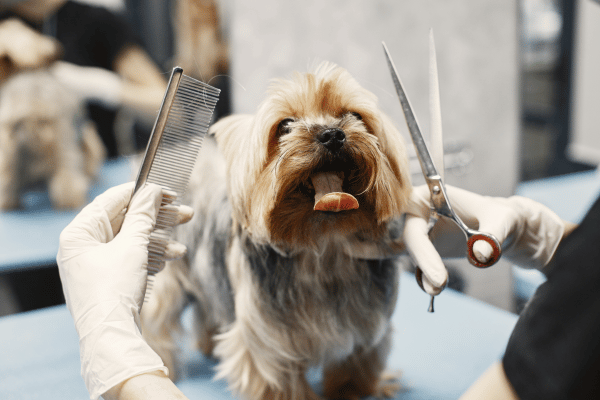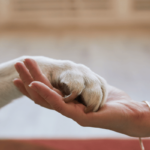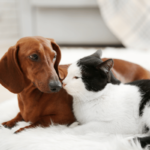Discover essential grooming tips for pets to maintain their hygiene. This guide offers practical advice for pet owners, ensuring a healthy, clean, and happy life for your furry friends.
Regular Brushing: Key for Coat Health

Regular brushing is crucial for your pet’s coat health. It removes dirt, spreads natural oils, and prevents matting, especially in long-haired breeds. Brushing also allows you to check for any abnormalities, such as lumps or parasites. For effective grooming, use a brush suited to your pet’s coat type. Additionally, brushing provides a bonding experience, strengthening the emotional connection between you and your pet.
Incorporating brushing into your routine ensures your pet’s coat remains healthy and shiny. For dogs, brushing frequency depends on their coat type; short-haired breeds may need weekly brushing, while long-haired breeds often require daily attention. Cats, particularly long-haired ones, also benefit from regular brushing to prevent hairballs. Moreover, grooming sessions offer the perfect opportunity to check for fleas and ticks, crucial for maintaining your pet’s overall health.
Brushing not only improves appearance but also stimulates blood circulation, enhancing skin health. It’s essential for pets with shedding issues, as it helps manage loose fur and reduces the amount found around the house. Transitioning to regular brushing can be smooth if you start early in your pet’s life, making it a positive and enjoyable experience. Remember, gentle strokes and patience are key, especially for pets new to grooming.
Bathing Basics for Optimal Pet Hygiene
Bathing plays a pivotal role in pet hygiene. It’s essential to use pet-specific shampoos to maintain skin health and coat quality. The frequency of baths depends on your pet’s breed, lifestyle, and skin needs. Dogs with oily coats may require weekly baths, whereas those with water-repellent coats need less frequent bathing. Cats generally groom themselves but might need occasional baths, especially if they’re unable to clean themselves properly due to age or health issues.
When bathing your pet, ensure the water temperature is comfortable. Gently massage the shampoo into their coat, avoiding eyes and ears. Rinsing thoroughly is crucial to prevent skin irritation. After the bath, towel dry your pet, followed by a hairdryer for breeds with dense fur. Regular baths not only keep your pet clean but also provide an opportunity to check for skin issues like rashes, dry patches, or signs of allergies.
Bathing your pet also helps in controlling external parasites. It’s a key element in managing fleas and ticks, especially when combined with vet-recommended treatments. For pets that resist baths, positive reinforcement with treats and gentle coaxing can help. Remember, the goal is to make bath time a stress-free experience. Additionally, it’s important to trim nails and clean ears during grooming sessions, as these are often overlooked aspects of pet hygiene.
Grooming Tips for Pets: Dental Care
Dental care is a vital aspect of grooming tips for pets. Regular teeth cleaning prevents tartar build-up, gum disease, and bad breath. Use a pet-specific toothbrush and toothpaste for daily brushing. For dogs, dental chews can be effective in reducing plaque. Cats also benefit from dental care, although they may be less cooperative. Start dental hygiene routines early and gradually introduce toothbrushing to make it a more accepted part of your pet’s grooming routine.
Neglecting dental hygiene can lead to serious health issues in pets. Infections originating in the mouth can spread to other parts of the body, impacting overall health. Therefore, regular dental check-ups with a veterinarian are crucial. These check-ups can identify potential problems early, allowing for timely intervention. Additionally, feeding your pet a balanced diet helps maintain oral health, as some foods are designed to reduce plaque and tartar build-up.
While brushing remains the gold standard for dental care, alternatives like dental toys and water additives can supplement routine care. Always choose products specifically designed for pets, as human dental products can be harmful. Remember, good dental hygiene is not just about a bright smile; it’s about ensuring your pet’s overall well-being. Incorporating dental care into your regular grooming routine is a step towards a healthier, happier life for your furry companion.
Healthy Ears and Eyes: Grooming Essentials

Keeping your pet’s ears and eyes clean is essential for their overall health. Regular checks can prevent infections, especially in breeds prone to ear issues. Gently clean the ears with a pet-safe cleaner and a soft cloth or cotton ball. Avoid inserting anything deep into the ear canal. For the eyes, use a damp cloth to wipe away any discharge. Always approach this gently, as pets can be sensitive about their ears and eyes.
Ear and eye care are often overlooked in routine grooming. However, they are critical for detecting early signs of infection or irritation. For dogs with floppy ears, it’s particularly important to ensure good air circulation and regular cleaning. Cats, while generally good at self-cleaning, may need assistance if they develop eye discharge. Always seek veterinary advice if you notice any unusual signs like redness, swelling, or a bad odor.
Integrating ear and eye care into your regular grooming routine doesn’t just keep your pet looking good; it also plays a significant role in their health. Regular maintenance helps prevent common problems like ear mites, yeast infections, and conjunctivitis. Starting these grooming habits early in your pet’s life can make them more comfortable with the process. Remember, gentle handling and positive reinforcement make these grooming tasks easier for both you and your pet.
Nail Trimming: Vital for Pet Comfort
Nail trimming is an essential aspect of pet grooming, vital for their comfort and mobility. Overgrown nails can cause pain and lead to posture problems. For dogs, regular trimming prevents nails from becoming too long and curling into the paw pads. Cats may require less frequent trimming but monitoring is key to avoid overgrowth. Start this practice early and handle your pet’s paws regularly to make them comfortable with the process.
The frequency of nail trimming varies with each pet’s activity level and growth rate. Active dogs naturally wear down their nails, requiring less frequent trims. For indoor cats and less active dogs, more frequent trimming is necessary. Always use a pet-specific nail clipper and be cautious to avoid cutting the quick, which can be painful and bleed. If unsure about the process, seek advice from a veterinarian or a professional groomer.
Trimming your pet’s nails not only prevents physical discomfort but also protects your furniture and skin from scratches. For anxious pets, creating a calm environment and gradually introducing nail trimming can help. Offering treats and praise during and after the process encourages positive associations. Remember, patience and consistency are key. If you’re not comfortable doing it yourself, regular appointments with a professional groomer can ensure your pet’s nails are properly maintained.
Effective Parasite Control in Grooming
Effective parasite control is a critical component of grooming tips for pets. Regular grooming sessions are the perfect opportunity to check for fleas, ticks, and other parasites. These pests can cause discomfort and lead to health issues. For effective control, use veterinarian-recommended flea and tick prevention products. Additionally, frequent grooming allows for early detection and treatment, minimizing the risk of infestation and ensuring your pet’s health and comfort.
Parasite prevention is crucial year-round, not just in warmer months. Fleas and ticks can survive in many environments and can cause serious diseases. Regular grooming, combined with preventive treatments, reduces the likelihood of these pests. For pets with thick or long fur, extra attention is needed as parasites can hide easily. Always follow the instructions on preventive products and consult your vet for the best options for your pet.
In addition to external parasites, grooming can also help in monitoring for signs of internal parasites. While grooming, look for signs like coat dullness or changes in behavior, which could indicate an issue. Regular vet check-ups, including fecal exams, are essential for internal parasite control. Remember, keeping your pet parasite-free is not only important for their health but also for the health of your family and other pets.
Maintaining a Healthy Diet for Grooming
A healthy diet plays a crucial role in the grooming and overall well-being of your pets. Proper nutrition ensures a shiny, healthy coat and good skin health. Include balanced pet food that provides essential nutrients, vitamins, and minerals. For pets with specific dietary needs or skin conditions, consult a veterinarian for specialized food recommendations. Remember, a healthy inside reflects on the outside, making diet an integral part of your pet’s grooming routine.
Certain foods can enhance your pet’s coat and skin health. Omega-3 and Omega-6 fatty acids, found in fish oil and flaxseed oil, are particularly beneficial for maintaining a shiny coat and healthy skin. Antioxidant-rich foods can also support skin health. Always ensure your pet’s diet is age-appropriate and breed-specific. Additionally, providing fresh water at all times is essential for hydration, which directly impacts skin and coat condition.
Be mindful of any food allergies or sensitivities your pet may have, as these can affect their skin and coat health. Symptoms like excessive scratching, bald patches, or skin irritation can indicate dietary issues. Regular veterinary check-ups can help identify and address any dietary concerns. Integrating a balanced diet with regular grooming practices leads to a healthier, happier pet with a vibrant coat and robust skin.
Grooming Tips for Pets: Seasonal Care
Seasonal changes significantly impact your pet’s grooming needs. During spring and summer, increased shedding requires more frequent brushing to remove loose fur. These seasons also call for heightened flea and tick prevention. In contrast, winter can dry out your pet’s skin, necessitating moisturizing treatments and possibly a reduction in bathing frequency. Adapting grooming routines to the seasons ensures your pet remains comfortable and healthy throughout the year.
In colder months, consider using pet-safe paw balms to protect their paws from salt and ice. Short-haired breeds may benefit from sweaters or coats to keep them warm during walks. Conversely, in hotter months, ensure your pet stays hydrated and groom them to prevent overheating. Be mindful of hot surfaces that can burn paws, and provide shade and cool water during outdoor activities. Seasonal grooming is about adapting to your pet’s changing needs.
Remember, grooming is not just about appearance; it’s about comfort and health. Regular vet check-ups should accompany your grooming routine to address any seasonal issues that arise. Pay special attention to your pet’s behavior and physical condition, as these can indicate how well they’re adapting to seasonal changes. Grooming tips for pets should always include considerations for the weather and environmental conditions, ensuring your pet’s well-being year-round.
Understanding Your Pet’s Grooming Signals
Understanding your pet’s grooming signals is key to providing the best care. Pets communicate their discomfort or pleasure during grooming through body language. Signs of stress, like excessive panting, drooling, or trying to escape, indicate a need for a gentler approach or a break. Conversely, relaxed body posture and content sounds show they’re enjoying the grooming session. Paying attention to these signals enhances the grooming experience for both you and your pet.
Each pet has individual grooming preferences and tolerances. Some may enjoy longer brushing sessions, while others might be sensitive to certain grooming activities. It’s essential to respect these preferences and adjust your grooming routine accordingly. For pets with past traumatic experiences or sensitivities, slow and gradual exposure to grooming, coupled with positive reinforcement, can help overcome their fears. Always prioritize your pet’s comfort, making grooming a positive, stress-free experience.
Creating a calm grooming environment is crucial. Choose a quiet place and use soothing tones. Introduce grooming tools gradually, letting your pet sniff and get accustomed to them. Reward calm behavior with treats and affection. Over time, this positive association can transform grooming into a bonding experience. Remember, grooming is an opportunity to strengthen your relationship with your pet, fostering trust and understanding while ensuring their physical well-being.
Professional Grooming: When to Consider
Professional grooming can be a valuable resource for pet owners. While regular home grooming is essential, certain situations call for a professional’s touch. This includes handling challenging breeds, dealing with severe matting, or when your pet requires special grooming care due to health issues. Professional groomers have the tools and expertise to handle these situations effectively, ensuring your pet’s safety and comfort.
Professional grooming services offer a range of options, from basic bathing and trimming to more specialized treatments like de-shedding and styling. They can also provide services like ear cleaning, nail trimming, and anal gland expression, which might be challenging for some pet owners to perform at home. Utilizing these services can help maintain your pet’s hygiene and appearance, especially for breeds with demanding grooming needs.
Choosing the right professional groomer is crucial. Look for someone experienced, with good reviews, and preferably with knowledge of your pet’s specific breed. A good groomer not only takes care of your pet’s physical appearance but also ensures their emotional well-being during grooming sessions. Remember, even if you opt for professional grooming, regular at-home care is still vital for your pet’s overall health and happiness.
In Summary
In conclusion, effective grooming is integral to your pet’s health and happiness. Incorporating these “Grooming Tips for Pets” into your routine ensures a well-maintained coat, good hygiene, and overall wellness. Regular grooming sessions not only keep your pet looking great but also provide an opportunity to bond and check for any health issues. Always approach grooming with patience and understanding, adapting to your pet’s individual needs and preferences.
Remember, grooming is not just about aesthetics; it’s a critical component of your pet’s health care. Regular brushing, bathing, dental care, nail trimming, and parasite control contribute significantly to their well-being. Seasonal grooming adjustments and understanding your pet’s grooming signals can further enhance their comfort. Whether grooming at home or opting for professional services, the key is consistency and attentiveness to your pet’s grooming requirements.
We encourage pet owners to embrace grooming as a joyful and rewarding aspect of pet care. Share your experiences and tips with our community in the comments below, or visit our website for more pet care advice. Your engagement helps us create a supportive network for pet enthusiasts. Let’s continue to provide the best care for our furry friends, ensuring they lead healthy, happy lives.
II. Dog and Cat Care FAQs
- Do dogs and cats care if we are naked?Dogs and cats generally do not have the same social norms and perceptions about clothing as humans do. They respond more to the scent, behavior, and body language of their owners rather than their state of dress or undress.
- Do cats and dogs worry about their babies?Cats and dogs exhibit parental instincts and can show concern for the well-being of their offspring. This includes providing food, protection, and teaching survival skills, although the intensity and duration of these behaviors can vary widely among individuals and breeds.
- Do dogs and cats understand that they are moving in cars?Dogs and cats can perceive motion and changes in their environment, so they do understand on some level that they are moving when in cars. Their reactions to car rides can vary, with some enjoying the experience and others feeling anxious or sick.
- How do dogs and cats view car rides?Dogs and cats can have varied perceptions of car rides. Some dogs may find car rides exciting and associate them with positive experiences like going to the park. Cats might be more prone to stress in moving vehicles, often preferring stable and familiar environments.
- How is caring for dogs and cats different?Caring for dogs often involves more active engagement, including regular walks, socialization, and training. Cats typically require less direct interaction but need environmental enrichment, such as climbing structures and scratching posts. Dogs may thrive on routine and structure, while cats often prefer a more independent lifestyle.
- What is the difference in caring for a dog and a cat?The main difference lies in their needs for social interaction and exercise. Dogs generally require more time and effort in training, exercise, and social activities, while cats are more independent, needing less direct interaction but appropriate environmental enrichment.
- Is there a specific veterinarian for dogs and another for cats?While many veterinarians treat both dogs and cats, there are specialists known as feline veterinarians who focus exclusively on cat care. These specialists have in-depth knowledge of feline medicine and behavior.
- Can cats take care of themselves?Cats are known for their independence but still require human care for food, health, and safety. While they can perform basic grooming and hunting behaviors, domestic cats rely on their owners for their well-being.
- How long does it take for the mother of the puppy and cat to forget that they are her children?The maternal bond in dogs and cats can diminish over time, especially after weaning, which typically occurs around 6 to 8 weeks of age. However, the exact time it takes for a mother to "forget" her offspring can vary and is not well-documented.
- At how many months do dogs and cats stop breastfeeding their puppies?Dogs and cats usually wean their offspring around 6 to 8 weeks of age. This process can vary depending on the individual animal and circumstances.
- What is the care of a puppy and the difference between that of a cat?Puppies require consistent training, socialization, and more frequent feeding schedules. Cats, particularly kittens, need less socialization but require safe environments to explore and engage in natural behaviors like climbing and scratching.

Join Dan Morgan at dwfocus.com, your hub for ‘4 paws and owners’ wisdom! Explore a world where pet care meets expert insights, crafted by Dan, a seasoned vet with a heart for animals. Engage with stories, tips, and advice that every pet owner needs. From playful pups to graceful cats, Dan Morgan guides you through the joys and challenges of pet parenting. Embrace your love for pets with Dan’s expert guidance on dwfocus.com. #4PawsAndOwners #DanMorganPetExpert #dwfocus







